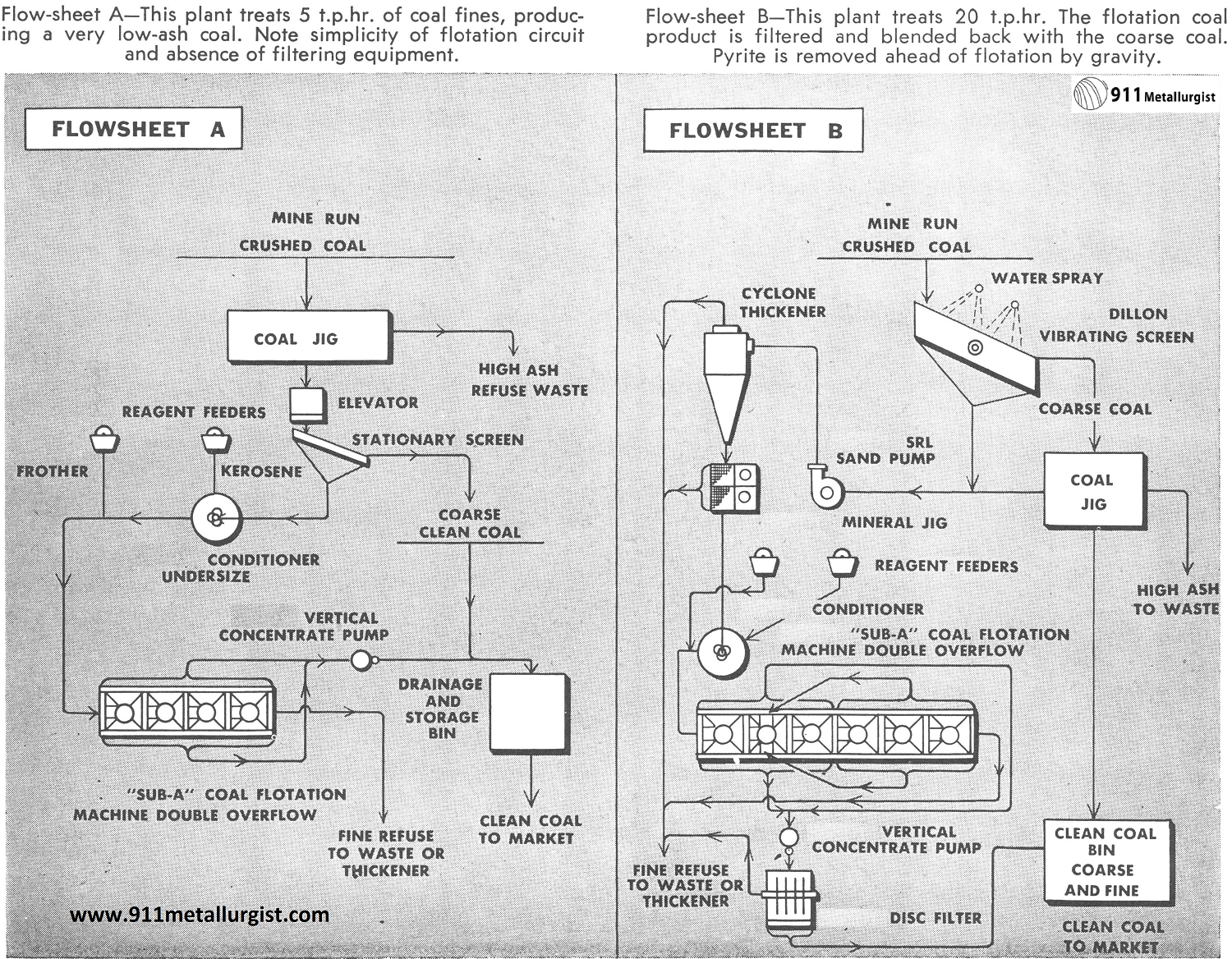Table of Contents
The Problem with Coarse and Fine Coal Beneficiation
Economic and operating conditions make it important to provide a simple, low cost, efficient method for recovering fine coal from washery waste. Not only is the water pollution problem a serious one, but refuse storage and disposal in many areas is becoming limited and more difficult. Many breakers and washeries efficiently handle the coarser sizes, but waste the coal fines. This problem is assuming major importance due to the increase in the amount of coal fines being produced by the mechanization of coal mining.
Flotation offers a very satisfactory low-cost method for recovering a fine, low ash, clean coal product at a profit. Often this fine coal, when combined with the cleaned, coarser fractions, results in an over-all superior product, low in ash and sulphur, giving maximum profit returns per unit mined.
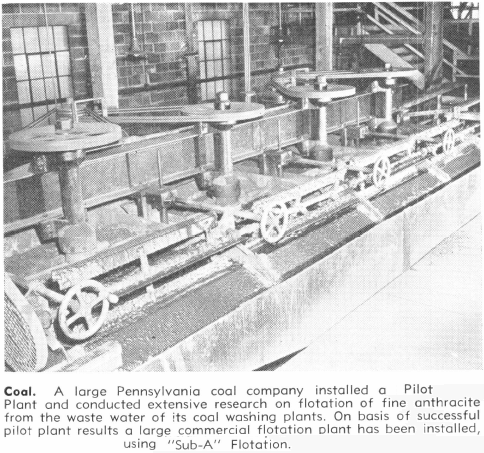
Fine Coal Flotation Circuit Flowsheet
Generally a very simple flotation flowsheet, as illustrated above, will be suitable for recovering the low ash coal present in waste from coarse recovery washeries. Assuming the fines are approximately all minus 20 mesh and in a water slurry of about 20% to 25% solids, the first step is to condition with a reagent which will promote flotation of the fine coal particles. Kerosene, fuel oil, coal tars and similar hydrocarbons will accomplish this effectively when added to the coal slurry in a (Patented) Super Agitator and Conditioner. A frothing agent such as pine oil, alcohol frother, or cresylic acid added to the slurry as it discharges from the conditioner is also used. The separation between low ash coal and high ash refuse is efficiently accomplished in a “Sub-A” Flotation Machine. As the amount of clean coal floated represents a high percentage of the initial feed, provision is made to remove the cleaned coal from both sides of the cell. Fine coal is dewatered with a Disc Filter, as the Flotation Machine can usually be regulated to produce a product low in ash and with proper density for direct filtration.
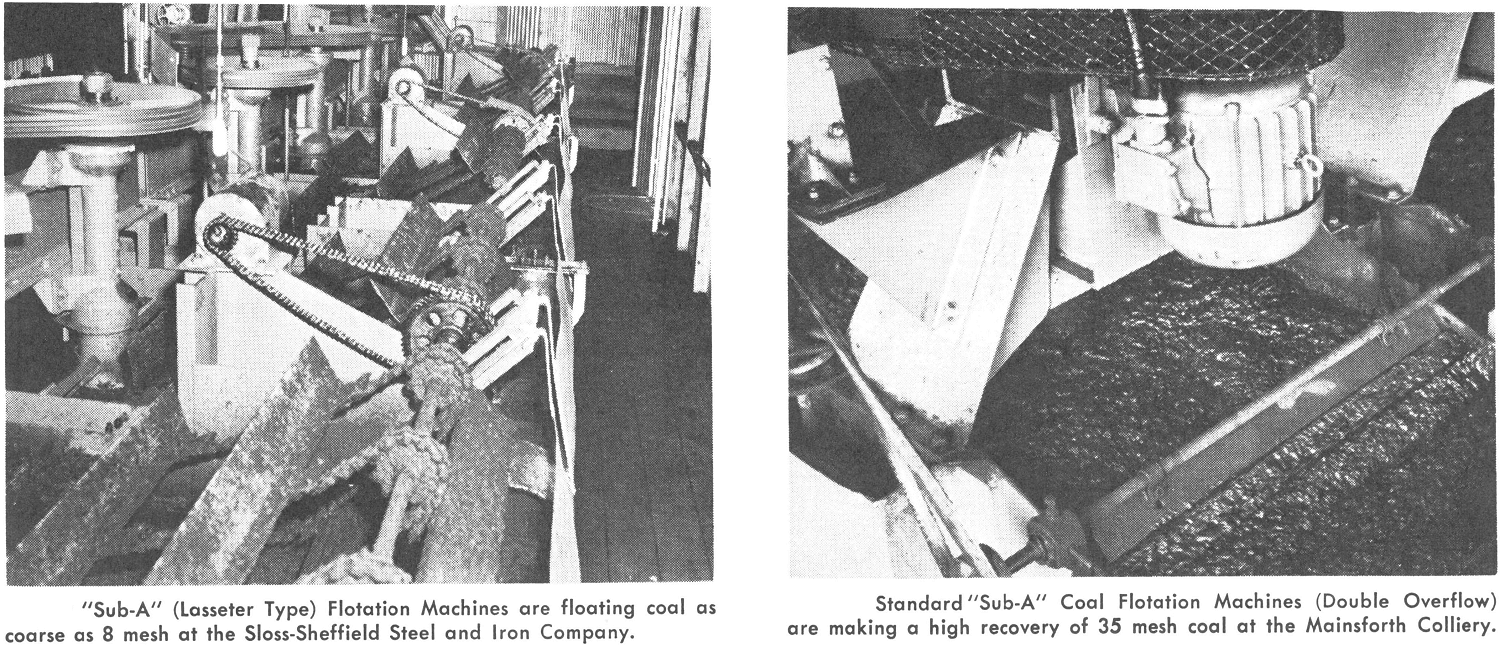
Typical operating results are as follows:

Coarse Coal Flotation Circuit
It is highly desirable to extend the range of coal flotation to include the coarser Sizes. Not only will this simplify general washery practice but will result in a superior product having desirable marketing characteristics for metallurgical and steam power plant uses. It is now possible to efficiently recover coal by flotation through the entire size range beginning at about 4 mesh down to fines, minus 200 mesh.
With the flowsheet as outlined for coarse coal recovery, the feed is first deslimed for removal of high ash slimes and excess water. The hydroclassifier underflow is conditioned at 40% to 45% solids with kerosene or fuel oil and diluted with water to 20%-25% solids prior to flotation. If pyrite and coarse high ash material are present, it is often helpful to pass the conditioned pulp over a Mineral Jig for removal of a portion of these impurities. Hindered settling in the jig against a rising pulsating water column classifies out the high gravity impurities and eliminates them from the flotation circuit. Water requirements are low and feed density to flotation can easily be maintained at the proper level.
The “Sub-A” (Lasseter Type) Flotation Machine has proved successful for treating coarse coal with the flowsheet as indicated. A frother of the alcohol type is generally added to the flotation feed after conditioning with kerosene. Floated coal will collect in a heavy dense matte at the cell surface and as raked off, will contain up to 60% solids. Mechanical dewatering is usually not necessary. Natural drainage, dewatering on porous bottom screw conveyors, and vibrating screen dewatering are all being used successfully in coarse coal recovery circuits.
Typical results from a coarse coal circuit are as follows.
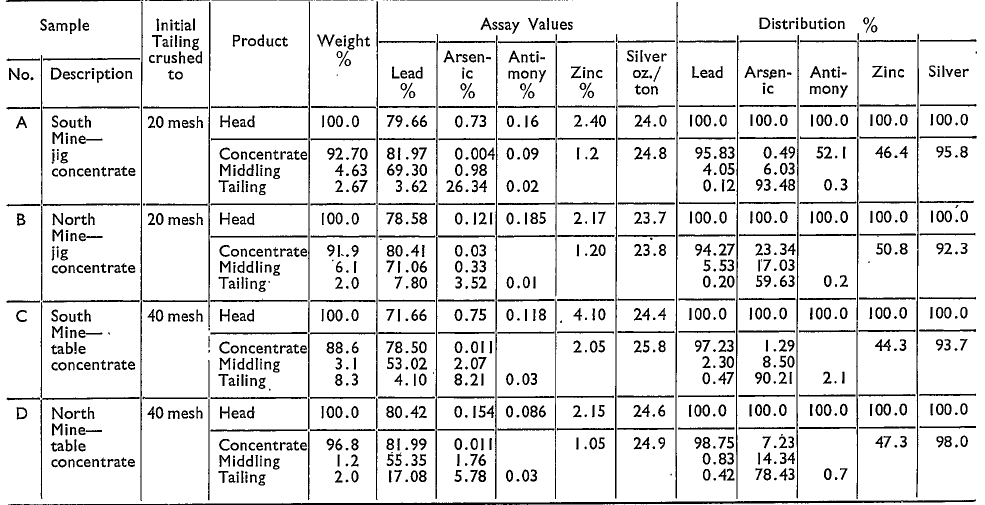
Modern Coal Preparation Advantages
Flotation, with the “Sub-A” gravity flow principle, provides the ideal way to treat coal fines even as coarse as —3/16” top size. According to reports from plants operating for the production of metallurgical coke, each percent ash in the coal carries a penalty of 2$ per ton of coal. Thus there is a considerable margin for operating costs in a fine flotation cleaning method that will materially lower the ash of the cleaned coal. Further convincing evidence that ash removal from coal is of major importance is found in the weekly magazine of metal working, Steel, January 29, 1951, reporting on a modern coal preparation plant. The report states that a 1% reduction in ash content of coal means a reduction of 30 cents in cost of pig iron. One large plant reduces the ash from 7% to 3.5% by cleaning, thus cutting the cost of producing pig iron a dollar or more per ton.
A coal flotation machine must not only be able to handle a coarse as well as a fine feed, but it must also be simple to operate. Gravity circulation permits the treatment of difficult unclassified feeds.

The Problem with Coal Recovery and Cleaning by Flotation
High cost of mining makes it very important from a profit standpoint to recover all of the low ash coal, both coarse and fines. With the present trend toward mechanization, more fines are produced in mining. In many operations it is no longer economical to discard these fines to waste even though ash contiminants render the fines unmarketable without additional cleaning.
Water conservation, stream pollution and refuse storage are also factors which must be taken into consideration along with marketing requirements for the clean coal product. Flotation offers an efficient and low-cost method for recovering coal fines at a profit. In many cases floated coal fines can be blended with the coarser fractions without affecting ash, moisture or size limitations. This is being done successfully in coking coal operations. Fine coal is also being used extensively in steam plants for electric power generation.
The Coal Recovery and Cleaning by Flotation Flowsheet Diagram
The above flowsheets are based on existing small coal flotation plants. They illustrate clearly the simplicity and feasibility of adding “Sub-A” Coal Flotation as an additional process to small washing plants.
Flowsheet “A”
This is a typical flowsheet for a small coal mine operation where low ash fines are contaminated with high ash materials due to mechanized mining.
Because of its limited output, treatment must be very simple and operating costs kept to a minimum. At the washery, illustrated by flowsheet “A,” the entire mine output is sold for coking coal. Mining the relatively narrow seam produces a product with 15 to 20% ash, although the coal when cleaned will carry only 3 to 3½% ash. This low ash coal brings a premium price, so it is an economic necessity to remove the impurities.
The mine run coal is crushed to a size for coking coal requirements. The entire production is treated over a coal jig which removes as waste primarily the coarse refuse. The coarse clean coal passes over the jig along with the fines and is elevated to a wedge bar stationary screen with 1 millimeter openings for dewatering. The coarse clean coal passing over the screen discharges by gravity into a storage bin. The fine coal, along with clay and its high ash fractions and water averaging 15 to 18% solids, discharges by gravity into a (Patented) Super Agitator and Conditioner. Kerosene and pine oil are added and the conditioned slurry or pulp then is introduced into the “Sub-A” Coal Flotation Machine.
The low ash coal is floated to the cell surface and is removed from both sides of the machine by revolving froth paddles. The refuse passes out the end of the machine and is discarded to waste.
The low ash coal product removed from the “Sub-A” Coal Flotation Cells contains 35 to 40% solids and is transferred to the coarse coal storage bin through a Vertical Concentrate pump. The flotation coal mixes with the coarse product which allows for adequate drainage and minimum loss of fines.
In addition to providing a means for maintaining a low ash marketable product, flotation recovered an additional 3 tons of fines per hour which heretofore were lost in the high ash waste.
No additional labor was necessary to operate the washery after installation of the flotation section.
Addition of flotation to this plant cost approximately $50,000 installed and ready to operate.
Flowsheet “B”
In the operation as illustrated by flowsheet “B,” approximately 15 tons per hour of coal flotation concentrate are produced. This installation requires more control to meet specifications and consequently a more elaborate system is necessary.
Mine run coal, after crushing, is wet screened to remove fines and the coarse fraction is treated by gravity to produce a dewatered high ash refuse which is discarded to waste.
Screen undersize and water containing fines from the gravity separator are thickened in a centrifugal or cyclone separator to give the proper water-to-solids ratio for subsequent treatment. The effluent from the cyclone contains collodial slimes and high ash fines in addition to the bulk of the water from screening and gravity systems. Thickened coal fines from the cyclone pass over a Mineral Jig which removes a high ash refuse and free pyrite down as fine as 150 to 200 mesh.
The coal fines passing over the Jig are conditioned with reagents in the (Patented) Super Agitator and Conditioner and subjected to flotation treatment in a 6-cell “Sub-A” Coal Flotation Machine at approximately 20-25% solids. Double overflow of froth is used due to the low ratio of concentration and the high weight percentage of floatable coal recovered by flotation.
The coal flotation product at 35% solids is dewatered by a Disc Filter. Coarse coal from the gravity section and fine coal from the flotation section are blended and transferred by rail to the coke plant.
In some cases the coarse and fine coal are dewatered by Dillon Vibrating Screens. The coarser fractions of coal are first added to the screen to form a bed and flotation fines are added on top of this bed for dewatering. Where operating conditions are favorable, this system is preferred to other means of dewatering as it assures a well blended product low in moisture and uniform in ash content.
Effluent from the cyclone, high ash jig refuse and flotation tailing refuse are thickened in a Thickener to conserve and re-use water. Thickener refuse is disposed of without contaminating local streams.
MODERN COAL PREPARATION ADVANTAGES
“Sub-A” Coal Flotation with its gravity flow principle and selective action makes it possible to recover low ash coal from 1/8” down to minus 200 mesh. If an appreciable amount of recoverable coal is plus 20 mesh in size, the “Sub-A” Lasseter Type Coal Flotation Machine should be used. It is no longer necessary to use a complex system for fine coal recovery. Flotation will effectively handle the entire fine size range at low cost and produce a low ash marketable product.
Related information on Laboratory Coal Flotation Tests and the following articles giving details on various coal flotation installations and flotation data:
Title of Article
- How to Schedule a Coal Flotation Test
- Coal Flotation Practice
- Froth Flotation Recovers Marketable Coal
- Coal Cleaning in Great Britain
- Flotation of Coal Fines
- Floating Fines with Kerosene
- Cleaning and Dewatering Fine Coal
- Selective Separation of Super Low Ash Coal by Flotation
- Coarse Coal Flotation
- Denby Hall Coal Preparation Plant
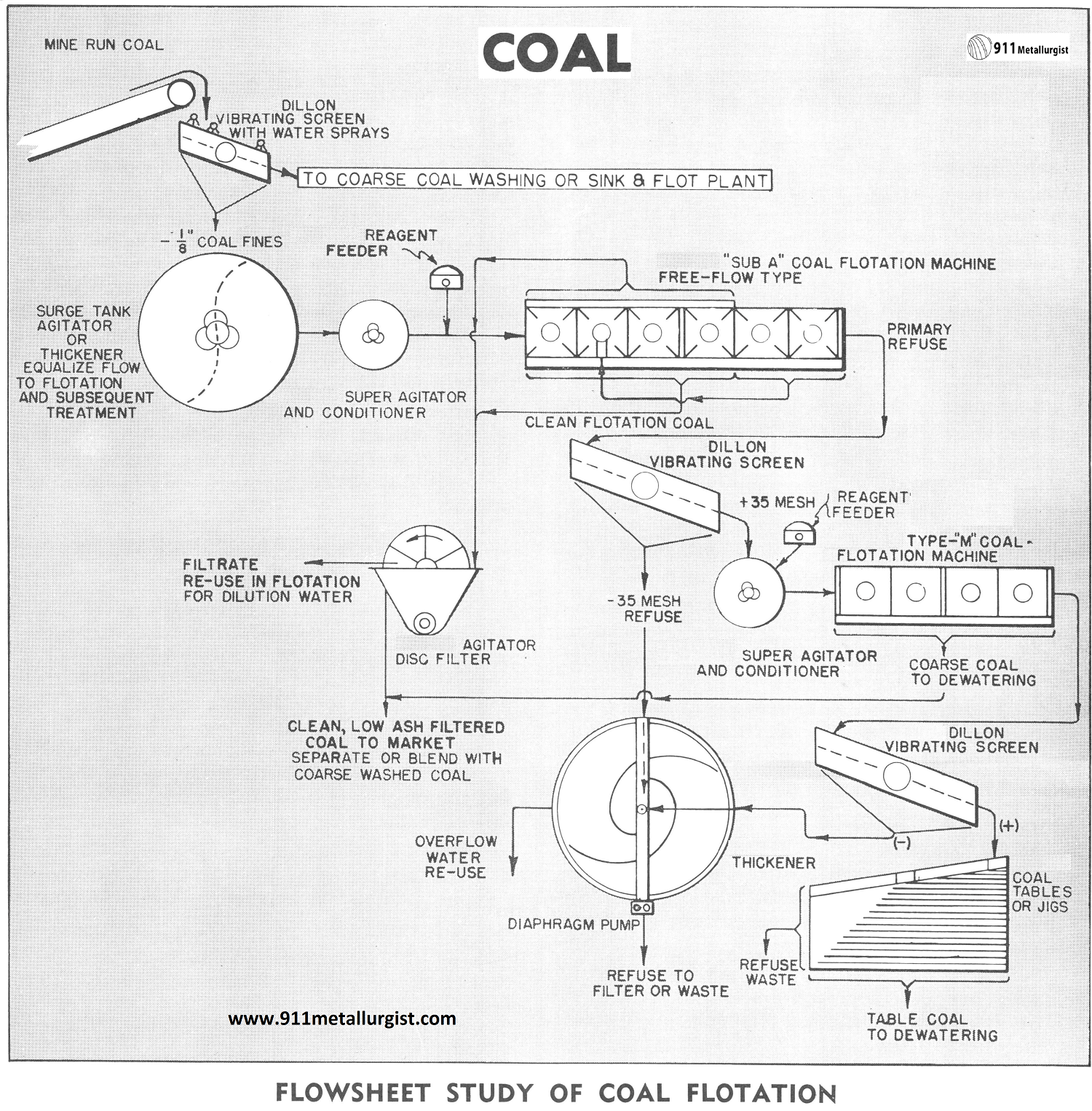
Coal Flotation Problems
In the washing of coal the problem exists in having to clean the fines in an economical and efficient manner without an excessively complex flowsheet. Mechanized mining creates fines not considered as problems in older methods of selective mining and underground loading. In many cases the minus 1/8 inch fines require cleaning to lower the ash content and frequently it is also necessary to reclaim all of the water for re-use in the washing system. Most plants use a closed water system to conserve water and comply with anti-stream pollution regulations.
Solution
Flotation offers a means for handling the entire size range minus 1/8 inch x 0. Efficient recovery of the fines at a low ash content is accomplished in a relatively simple flowsheet. The substantial amount of coarser sizes in the concentrates aids in subsequent dewatering either by vacuum filters or dewatering screens.
Description of the Coal Process Flowsheet Diagram
Screening and Washing
In the flowsheet shown mine run coal after proper size reduction treatment is passed over heavy duty screening equipment to remove the minus 1/8 inch fines. Wet screening down to 10 or 12 mesh offers no particular problem. Water sprays are generally employed to thoroughly wash the fines from the coarse coal and prepare it for treatment. A surge tank or a thickener ahead of the conditioning and flotation section may be necessary to provide a uniform feed rate both as to solids content and density.
Coarse Coal Treatment
The coarse coal is washed and up graded in a conventional manner through heavy media or coal jigs to produce a clean coal and a coarse refuse. Any fines due to degradation through the coarse cleaning system is collected, partially dewatered and combined with the fines from the screening section.
Conditioning and Density Control
Minus 1/8 inch x 0 coal fines are conditioned with the required amount of fuel oil or kerosene (approximately 1 to 3 lbs/ton) to thoroughly activate the low ash coal particles and render them floatable. Density in the conditioner should be as high as possible; however, for the open circuit system as shown it very likely will be maintained between 20 to 25% solids. A Super Agitator and Conditioner is preferred for this service since any froth accumulation on the surface is drawn down the standpipe and thoroughly dispersed throughout the pulp. This also aids in the most effective use of reagents.
Primary Flotation
The discharge from the conditioner at 20% solids is floated in a “Sub-A” Flotation Machine of the free flow type for handling coarse solids. Some dilution water may be necessary to maintain the feed density at 20% solids. A frother such as pine oil, cresylic acid, or one of the higher alcohols is added to the head of the flotation circuit at the rate of about 0.5-1.5 lbs/ton.
In the primary flotation section a high recovery of the coal fines minus 28 mesh is secured. In addition some of the more readily floatable coarse coal, low in ash, is also recovered. However, ability of the machine to handle all 1/8 inch feed permits recovery of coal over wide range of mesh sizes, thus improving filtering and handling characteristics. This coal, if not clean enough, is refloated in cleaner cells and middlings are recycled back to the feed. Clean coal will contain about 35% solids which is ideal for vacuum filtration. A Agitator Type Disc Filter is used as solids are effectively kept in suspension giving uniform distribution of cake for greater dewatering.
Dewatering and Coarse Coal Recovery
Generally the refuse from the primary flotation cells will contain a very high ash content in the -28 or-35 mesh size fraction. By screening the refuse the excess water and undersize high ash fines are eliminated while screen oversize is re-treated by flotation. This screening need not be highly efficient since only a partial sizing is satisfactory. Handling the coal in this manner reduces size degradation to a minimum.
Coarse Flotation
The coarse coal from the foregoing dewatering and screening step is repulped to about 40% solids and conditioned with reagents. The conditioned pulp after dilution to 25 to 28% solids is floated in a second bank of flotation cells. The coarse coal in the absence of fines will form a dense, heavy matte at the surface of the cells. For this type of flotation, slow moving rakes are provided to remove the coal as final concentrate. This clean coal will generally contain over 50% solids, thus making it ideal for dewatering over vibrating screens or on a horizontal or top feed vacuum filter. In some plants where moisture is not too critical a screw conveyor with wedge bar bottom sections is used for the dewatering step.
Screening and Final Coarse Recovery
The refuse from the coarse coal flotation cells may still contain some coal not responsive to flotation recovery but low enough in ash to be saved. In such cases the refuse can be screened and the oversize fraction jigged or tabled. The tonnage at this point is usually only a very small percentage of the initial fines so the equipment requirements for this gravity section are moderate.
Thickening and Filtration
All refuse in the 1/8 inch x 0 coal recovery section is collected in a thickener for water reclamation. The thickened refuse or sludge underflow may be pumped to waste ponds, or if water is in short supply, filtration of this refuse may be necessary.
Coal flotation concentrates produced in this primary section are filtered direct and the filtrate is re-cycled back to the flotation cells for re-use. This filtrate is high in reagent content and is particularly useful as dilution water. Generally the density of the coal from the primary cells will contain about 35% solids and thus does not require thickening ahead of filtration.
Coal from the coarse flotation and the gravity section, if employed, can be readily dewatered over screens or horizontal or top feed filters. In some cases it may be possible to divert part or all of this coal to the filter handling the fines provided it is equipped with proper agitation equipment and a high displacement vacuum system. Some of the new synthetic filter bag fabrics such as Saran and nylon materially aid in securing high filter rates and low final moisture content.
Remarks on Coal Beneficiation Process and Diagram
“Sub-A” Coal Flotation Systems have been successful for recovery of both coarse and fine coal. It is important, however, to employ a two-stage circuit for maximum efficiency in saving the plus 28 mesh fraction which is normally the most difficult to float. The development of the free flow and Type M flotation cells offers a means for efficiently handling coarse coal in a size range heretofore reserved for other more complex systems.
Laboratory, and in some cases, pilot plant tests, are advisable for establishing the flowsheet for a specific fine coal fraction. The flowsheet suggested is only one of many possibilities.
Coal Beneficiation Process
Market Specifications
Ash and sulphur content is desired to be as low as, or lower than, for regular lump coal. Generally, for anthracite, not over 13 per cent ash is desired. Bituminous coal operations usually limit ash to not more than 8 per cent in the fines.
Production Problems
Flotation or gravity concentration are generally applied only to washery fines that otherwise would not be saleable and which generally have to be impounded to prevent stream pollution. Because of the low price secured, the expense of treatment must be held to a minimum. Pyrite and coarser ash-forming content may need to be removed by gravity treatment.
The trend toward mechanized mining methods has increased the production of coal fines, thus increasing the necessity of fine-coal cleaning. Flotation offers the best solution to this problem.
Reagent Combinations
Kerosene or fuel oil with pine oil, or alcohol, frother are the more common reagents used. Cresylic acid frother may sometimes be advantageous. Fine pyrite, if free, may be rejected with the high-ash refuse by addition of lime to the flotation feed.
Under proper conditions, coal as coarse as 10 mesh may be effectively floated with kerosene and pine oil. For this coarse flotation it is generally necessary to classify out the high-ash —200 mesh slimes ahead of flotation.

Coal: Stainless steel scrapers remove dense coal matte froth in this “Sub-A” Lasseter installation where ash content is reduced to produce a marketable product.
Source: This article is a reproduction of an excerpt of “In the Public Domain” documents held in 911Metallurgy Corp’s private library.

